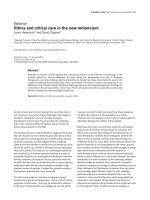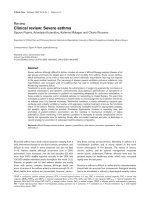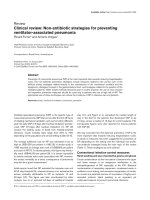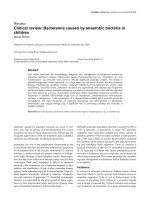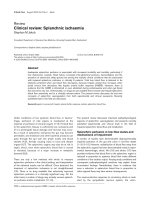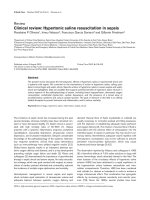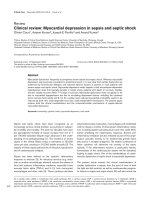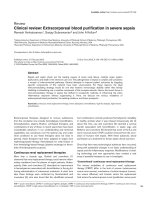Báo cáo y học: "Clinical review: Critical care medicine in mainland China" ppt
Bạn đang xem bản rút gọn của tài liệu. Xem và tải ngay bản đầy đủ của tài liệu tại đây (149.22 KB, 6 trang )
Healthcare in China
During the past three decades - the era of economic
liberalization in mainland China - China has had one of
the world’s fastest growing economies. However, health-
care development in China is far behind its economic
growth. e performance of China’s healthcare system
was rated poorly compared to that of other countries
according to e World Health Report 2000 - Health
Systems: Improving Performance [1].
In China, total healthcare expenditure accounts for 4.5%
to 5.6% of gross domestic product (Table1). Although the
trend shows that an increasing proportion of total
healthcare expenditure has been funded by the govern-
ment since 2001, the government paid only 20.3% of the
expenditure in 2007 [2,3]. On the other hand, the urban
basic healthcare insurance program in China is still in a
development period, covering only 359.5 million people
(52.2% of the urban population, or 27.1% of the total
population) in 2008 [3]. However, other forms of insur ance
program are under development, especially in rural areas.
Healthcare in mainland China is not cheap. e annual
cost of medical care for a citizen in China increased from
US dollars (USD) 42.9 in 2001 to USD 125.7 in 2008,
corresponding to 7.2% and 10.1% of annual income per
capita, respectively (Table 1).
History of critical care medicine in mainland China
Although advanced life support techniques, especially
positive pressure ventilation, inspired the development of
critical care medicine in Europe and North America in
the 1950s, critical care medicine is still one of the newest
disciplines of clinical medicine in mainland China.
As in many other countries, critical care was initially
practiced in a variety of postoperative recovery rooms
and/or an isolation area within the general ward. It is well
recognized that the fi rst ICU in mainland China was set
up in the Peking Union Medical College Hospital in 1982,
in the form of a surgical ICU with only one bed [4,5].
Two years later, it became the fi rst Department of Critical
Care Medicine in mainland China, with a seven-bed
general ICU in the Peking Union Medical College Hospital,
chaired by Dr Dechang Chen, the well-recognized found-
ing father of critical care medicine in mainland China.
In November 1989, the Ministry of Health issued the
Regulation of Hospital Accreditation and Management,
which required the establishment of an ICU as a pre-
requisite for accreditation as a tertiary hospital [4,5].
Many ICUs were set up in hospitals all over China
following the release of this document. Many physicians
(including general surgeons, internists, emergency physi-
cians, and anesthesiologists) were sent to other hospitals
for critical care training, either abroad or domestically,
before returning to practice as intensivists [4,5].
Development of critical care medicine as a
specialty in mainland China
In mainland China, physicians of other relevant special-
ties were the fi rst to be assigned to work in ICUs because
of their familiarity with the necessary techniques (anes-
thesiologists), disease entities (surgeons and internists),
and required urgency of treatment (emergency physi-
cians). However, after years of hard work, the important
role of intensivists, as a coordinator during patient
Abstract
Critical care medicine began in mainland China in
the early 1980s. After almost 30 years of e ort, it
has been recognized as a specialty very recently.
However, limited data suggest that critical care
resources, especially ICU beds, are inadequate
compared with those of developed countries. National
critical care societies work together to set up good
practice standards, and to improve academic levels
with scienti c meetings, education programs, and
training courses. Critical care research in mainland
China is beginning to evolve, with great potential for
improvement.
© 2010 BioMed Central Ltd
Clinical review: Critical care medicine in mainland
China
Bin Du*
1
, Xiuming Xi
2
, Dechang Chen
1
and Jinmin Peng
1
; on behalf of China Critical Care Clinical Trial Group (CCCCTG)
REVIEW
*Correspondence:
1
Medical ICU, Peking Union Medical College Hospital, Peking Union Medical
College and Chinese Academy of Medical Sciences, 1 Shuai Fu Yuan,
Beijing100730, China
Full list of author information is available at the end of the article
Du et al. Critical Care 2010, 14:206
/>© 2010 BioMed Central Ltd
evaluation and treatment, has gradually been recognized
and respected by other specialties. Junior physicians
interested in critical care training can choose to be
intensivists after they fi nish 3 or 4 years of fellowship
training in surgery or internal medicine. However, the
traditional specialties often still assume responsibility for
or ‘ownership’ of patients, as well as have a desire to treat
critically ill patients, as refl ected by the fact that the
proposal for setting up a critical care society under the
Chinese Medical Association (CMA) was rejected in 1996.
Public healthcare crises in China since 2003 have
provided intensivists with an opportunity to demonstrate
their knowledge and skills. Epidemics of severe acute
respiratory syndrome (SARS) in 2003, of Streptococcus
suis in 2005, and of avian infl uenza, as well as the
Wenchuan Earthquake in 2008, caused extreme anxiety
in the public due to the vulnerability of the general
population, the high communicability of the diseases,
and the high case fatality rate. erefore, intensivists
were often convened by the government to be involved in
crisis management very early [6]. eir ability to co-
ordinate, cooperate, and communicate with regard to
both patient management and policy-making was well
demonstrated during daily work, and recognised by the
general public and healthcare authorities. As a result,
critical care medicine was offi cially recognized as a
specialty of clinical medicine in 2009 [7].
Critical care resources and services
ere is no census on critical care resources in China,
including the number of ICUs, intensivists, ICU nurses,
and relevant facilities (for example, bedside monitors,
artifi cial ventilators), because no national survey has ever
been performed.
We performed computerized literature searches of the
China Academic Journals Full-text Database of the China
National Knowledge Infrastructure. We used the search
terms ‘intensive care unit’ or ‘intensive care’ or ‘critical
care unit’ and ‘survey’, and found only eight relevant
papers concerning critical care resources in mainland
Table 1. Summary of healthcare in China [2,3]
Year
2001 2003 2005 2007 2008
Population (million) 1,276.27 1,292.27 1,307.56 1,321.29 1,328.02
Urban (%) 37.7 40.5 43.0 44.9 45.7
Rural (%) 62.3 59.5 57.0 55.1 54.3
GDP (million USD) 1,405 1,709 2,669 3,611 4,402
GDP per capita (USD) 1,101 1,322 2,041 2,733 3,315
Annual income per capita (USD) 594 731 932 1,240 1,434
Urban (USD) 1,004 1,240 1,536 2,018 2,311
Rural (USD) 346 384 477 606 697
Total healthcare expenditure (million USD) 75.4 96.4 126.8 165.3 NA
Percentage of GDP spent on healthcare 5.37 5.64 4.75 4.58 NA
Percentage of total healthcare expenditure funded by the government 15.5 17.0 17.9 20.3 NA
Percentage of total healthcare expenditure funded by individuals 60.5 55.8 52.2 45.2 NA
Population covered by insurance (million)
Urban 76.3 109.0 137.1 220.5 317.0
Rural NA NA NA 31.3 42.5
Cost of medical care (USD)
Per visit 13.7 15.8 18.6 19.9 21.4
Per admission 475.2 572.6 682.5 728.2 800.0
Annual medical service per capita
Visit 1.64 1.62 1.76 2.52 2.66
Admission 0.043 0.047 0.052 0.074 0.086
Annual cost of medical care (USD)
Per capita 42.9 52.5 68.0 104.0 125.7
Percentage of annual income 7.2 7.2 7.3 8.4 10.1
GDP, gross domestic product; NA, not available; USD, US dollars. 1 USD = 6.83 RMB.
Du et al. Critical Care 2010, 14:206
/>Page 2 of 6
China [8-15] that were published within the past decade
(Table 2). Unfortunately, none of these eight papers
selected a representative sample of ICUs in China.
Table 2 summarizes data from these eight papers [8-
15], in addition to those of the China Critical Care
Clinical Trial Group (CCCCTG) [16]. Based on the above
data, we made a rough estimation that, in mainland
China, ICU beds might account for 1.8% (interquartile
range 1.3% to 2.1%) of total hospital beds [8-10,12-16]. In
2008, the Ministry of Health reported that there were a
total of 2,882,862 beds in 19,712 hospitals in China [3].
erefore, we estimate that there were 51,891 (37,477 to
60,540) ICU beds in China in 2008, corresponding to 3.91
(2.82 to 4.56) ICU beds per 100,000 population, with 217
hospital beds per 100,000 population. is fi gure is
comparable to that of the United Kingdom (3.5 ICU beds
per 100,000 population), which was the lowest of eight
countries in North America and Western Europe [17].
Among all ICUs, about half were closed (mean 51.6%,
range 45% to 73.5%), more than one-third were semi-
closed (mean 36.3%, range 26.9% to 41.9%), and the
others were open ICUs (mean 12.1%, range 0% to 18%)
[8-10,12-15]. e relative distribution of specialty ICUs
versus general ICUs was not uniform across the country,
with specialty ICUs making up from 35% (Shandong) to
66% (Jiangsu) of units, or 34% (Shandong) to 53%
(Beijing) of ICU beds [10,11,15].
In addition, the ICU nurse-to-bed ratio ranged from
1.37 to 2.02 [8-16], corresponding to 71,091 to 104,820
ICU nurses in mainland China. According to limited
data, there is no signifi cant diff erence in ICU beds and
nurse-to-bed ratios between coastal areas and inland
areas. Although there are usually more ICU beds in
tertiary hospitals than local hospitals, there is no diff er-
ence in nurse-to-bed ratio. Even few data are available for
bedside monitors, mechanical ventilators, and dialysis
machines, which preclude the possibility of making any
estimation.
ere has been no large-scale observational study
about case mix in Chinese ICUs, although some data are
available. Among 443 patients receiving mechanical
ventilation for more than 48 hours in 26 ICUs, mean age
was 62.4 ± 19.5 years, and 298 (67.3%) were male [18].
Medical reasons accounted for 58.2% of all ICU
admissions, followed by emergency surgery (22.8%), and
elective surgery (19.0%) [18]. Data from the CCCCTG
showed that, among 38,922 patients admitted to 24 ICUs
in 2007 and 2008, about two-thirds (66.2 ± 23.0%) were
treated with invasive mechanical ventilation, pulmonary
artery catheters or arterial pulse contour analysis was
used in 2.9 ± 3.6% of patients, and continuous renal
replacement therapy was used in 12.2 ± 11.4% of patients
[19]. e hospital mor tality rate was 13.1 ± 8.6% [19].
A 12-month prospective observational study in 10
surgical ICUs identifi ed 8.68% (318/3,665) of patients had
severe sepsis, with a hospital mortality rate of 48.7% [20].
Prospective and retrospective observational studies
suggested that 2.0% to 25.1% of ICU patients developed
acute respiratory distress syndrome [18,21-23]; the
hospital mortality rate ranged from 52.0% to 68.5%
[21-23]. e mean hospital cost for severe sepsis was
USD 11,390 ± 11,455, and the mean daily cost was USD
502 ± 401 [20], corresponding to 794% and 35% of annual
income per capita in 2008 (Table 1).
National critical care societies
As mentioned above, anesthesiologists, general surgeons,
emergency physicians and pulmonologists are all involved
in ICU management in mainland China. eir infl uence is
well described by the presence of critical care sections
Table 2. Critical care resources in mainland China [8-16]
Number Number Number Total Percentage Average Number of Number of
Year of of of hospital of ICU hospital ICU intensivists nurses
Ref. survey Region hospitals beds ICUs beds beds beds per ICU per ICU
[8]
a
1999 25 provinces 155 90,848 316 1,934 2.1 6.4 ± 4.8 5.9 ± 3.4 11.0 ± 6.5
[9]
b
2001 17 provinces 27 9,023 44 527 5.3 12 9.0 16.4
[10]
c
2005 Jiangsu 61 41,759 180 548 1.4 9.0 6.3 14.5
[11]
d
2005 Beijing 64 NA 126 1,092 NA 8.7 6.2 14.8
[12]
e
2006 Guangdong 41 39,205 43 572 1.6 ± 0.9 13.3 ± 7.4 8.9 ± 3.6 25.3 ± 6.6
[13]
f
2006 Guangdong 26 13,443 26 263 2.1 ± 0.8 10.1 ± 3.8 7.5 ± 2.5 18.2 ± 5.8
[14]
g
2007 Guangxi 34 22,425 34 281 1.4 ± 0.5 8.3 ± 4.0 7.3 ± 3.1 15.6 ± 4.1
[15]
h
2008 Shandong 139 77,665 196 1,702 2.2 ± 1.8 8.7 ± 5.9 6.9 ± 6.4 16.1 ± 10.1
[16]
i
2009 21 provinces 24 46,752 24 499 1.1 ± 0.5 20.8 ±14.1 13.2 ± 10.6 42.1 ± 32.1
a
Response rate 15.3% (155 out of 1,210).
b
Response rate 68% (27 out of 40), including 18 pediatric ICUs, 20 neonatal ICUs, and 6 mixed ICUs.
c
Including 30 tertiary
hospitals and 31 local hospitals.
d
Including 106 ICUs in 46 tertiary hospitals and 20 ICUs in 18 local hospitals.
e
Survey in tertiary hospitals.
f
Survey in local hospitals.
g
Including 22 ICUs in 22 tertiary hospitals and 12 ICUs in 17 local hospitals.
h
Including 87 ICUs in 50 tertiary hospitals and 109 ICUs in 89 local hospitals.
i
Data from 24
ICUs of 24 tertiary hospitals in 21 provinces. NA, not available.
Du et al. Critical Care 2010, 14:206
/>Page 3 of 6
within the associated professional societies, namely, the
Chinese Society of Anesthesiology, Chinese Society of
Surgery, Chinese Society of Emergency Medicine, and
Chinese Society of Respiratory Diseases.
Although the CMA refused to set up a critical care
society in 1996, the fi rst national critical care society in
mainland China was established in 1997, called the
Chinese Society of Critical Care Medicine (CSCCM), and
currently has about 500 members. e major objective of
the CSCCM is to provide a multidisciplinary platform for
promoting critical care medicine all over China, provide
expert opinion to the government and other bodies, and
encourage both national and international academic
exchange.
e CSCCM organizes a 3-day biennial national
conference, with attendees increasing from 200 in 1997 to
more than 1,000 people in 2006, including physicians,
nurses, and company representatives. In 2006, the CSCCM
hosted the 14th International Congress of the Asia Pacifi c
Association of Critical Care Medicine (APACCM) in
Beijing. e scientifi c program included 16 plenary
lectures, 130 lectures and workshops by 57 speakers from
19 countries. is was the fi rst time that an international
conference on critical care medicine had ever been held in
mainland China, a milestone demonstrating more
involvement in the international community.
Since its establishment, the CSCCM has developed close
relationships with multiple international profes sional
societies, such as the Society of Critical Care Medicine
(SCCM), the European Society of Intensive Care Medicine,
the Société de Réanimation de Langue Française, the
APACCM, and the World Federation of Societies of
Intensive and Critical Care Medicine (WFSICCM). Right
now, the CSCCM is the only member society representing
mainland China in both the WFSICCM and APACCM.
e second national critical care society, the Chinese
Society of Intensive Care Medicine, was established in
2005 under the CMA (CSICM-CMA). CSICM-CMA has
been working actively to enact clinical practice guide-
lines, including nutritional support, mechanical ventila-
tion, and sepsis management.
e third national critical care society, the Chinese
Association of Critical Care Physicians (CACCP), was
founded in July 2009. As an affi liation to the China
Medical Doctors Association, the aim of the CACCP will
include professional certifi cation of intensivists.
ese three societies have the common philosophy to
cooperate with each other in the future because they
share almost the same leadership.
Training of critical care physicians, nurses and
respiratory therapists
At present, there is no formal accredited critical care
training program in China. Residents can choose critical
care medicine as their specialty after graduation from
medical school. Rotation in other departments, such as
anesthesia or internal medicine, is not obligatory, and is
organized according to institution and department
requirements. On the other hand, residents may consider
critical care medicine as a subspecialty after fi nishing a
fellowship training program in internal medicine, anes-
thesia, general surgery, or emergency medicine.
ICU physicians can register as intensivists (for those
working in general ICUs), or, alternatively, remain
registered under their primary specialty of anesthes-
iology, internal medicine, general surgery or emergency
medicine (for those working in specialized ICUs) [7].
In mainland China, most nursing education programs
employ only a 3-year curriculum after senior high school.
Although colleague education programs have become
more and more popular, there is still a signifi cant demand
for professional education for nurses. In 2003, the Beijing
Nursing Association started to implement a critical care
nurse certifi cation program, with around 150 trainees
every year. e program is composed of 1 month of
lectures and 1 month of clinical practice, followed by
examination of knowledge and skills. Trainees are also
required to fi nish a review before certifi cates are issued.
In 2007, the China Nursing Association followed the
same model in order to meet the need in other cities in
mainland China.
Respiratory therapists are present in only a few ICUs.
Sichuan University set up the fi rst program of respiratory
therapy in a medical school in mainland China in 2002 [24].
Future development of critical care medicine in
mainland China
e lack of a national accredited critical care training
program is believed to be a major obstacle for improving
professional education in China. Although access to
state-of-the-art advances might be available during
national and international conferences, basic knowledge
and skills are inadequately, and sometimes incorrectly,
taught in many hospitals. For the past 5 years, the
CSCCM has dedicated itself to promoting professional
education with regard to basic knowledge and skills in
critical care medicine. e CSCCM successfully organi-
zes a Fundamental Critical Care Support course, a
Funda mental Disaster Management course, and a Multi-
professional Critical Care Review Course, with support
from the SCCM. In 2007, the CSCCM endorsed the Basic
Assessment and Support Intensive Care course, and
promoted the course in mainland China. Nine provider
courses have been organized until November 2009, with
more than 220 participants. However, an advanced
training program is still under development, and the
number of trainees is very limited compared with the
large number of intensivists in mainland China.
Du et al. Critical Care 2010, 14:206
/>Page 4 of 6
More over, a national board exam for critical care
medicine is not yet available, which suggests that we do
not have a minimum national standard for intensivists.
Critical care research in mainland China is in its
infancy. Most study results are published in national
medical journals in the Chinese language, while very few
investigators succeed in publishing their studies in peer-
reviewed international medical journals. Possible reasons
might include: inadequate training and experience in
clinical research; inadequate staffi ng dedicated to
research; inadequate funding for critical care research;
and inadequate language profi ciency.
However, Chinese intensivists have become more
actively involved in international multicenter studies
during recent years. For example, a total of 1,135 patients
in 57 ICUs in mainland China were enrolled in an obser-
vational study, accounting for 21% of patients and 14% of
ICUs (S Finfer, unpublished data). is suggests a great
potential for future improvement in clinical research in
mainland China.
Considering the above limitations and potential
improve ment, we do believe that Chinese intensivists
may benefi t from academic exchange with the inter-
national medical community with regard to the following:
development of a series of training programs fulfi lling
international standards; development of a national board
exam for critical care medicine; and conduction of
multicenter trials compatible with good clinical practice.
Conclusion
Overall, critical care medicine in mainland China is still
in a phase of development. After years of dedicated hard
work, critical care medicine has been recognized as a
specialty by the government and other specialties.
However, due to scarce resources and limited experience,
critical care training and clinical research are still
underdeveloped, which also represents a great potential
for future improvement.
Abbreviations
APACCM = Asia Paci c Association of Critical Care Medicine; CACCP = Chinese
Association of Critical Care Physicians; CCCCTG = China Critical Care Clinical
Trial Group; CMA = Chinese Medical Association; CSCCM = Chinese Society
of Critical Care Medicine; CSICM-CMA = Chinese Society of Intensive Care
Medicine - Chinese Medical Association; SCCM = Society of Critical Care
Medicine; USD = US dollars; WFSICCM = World Federation of Societies of
Intensive and Critical Care Medicine.
Author details
1
Medical ICU, Peking Union Medical College Hospital, Peking Union Medical
College and Chinese Academy of Medical Sciences, 1 Shuai Fu Yuan, Beijing
100730, China
2
Department of Critical Care Medicine, Fuxing Hospital, Capital University of
Medical Sciences, 20A Fuxingmenwai Avenue, Beijing 100038, China
Competing interests
The authors declare that they have no competing interests.
Published: 25 February 2010
References
1. World Health Organization: The World Health Report 2000. Health Systems:
Improving Performance. Geneva: World Health Organization; 2000.
2. National Bureau of Statistics of China: Statistical communique of the
People’s Republic of China on the 2008 National Economic and Social
Development [ />t20090226_402540710.htm]
3. Center of Statistics and Information, Ministry of Health: Statistical
communiqué of People’s Republic of China on the 2008 National
Healthcare Development [ les/business/
html les/mohwsbwstjxxzx/s8208/200904/40250.htm]
4. Qiu H, Chen D, Chen J: On exploration into critical care medicine and
disciplinary construction. Chin J Hosp Admin 2001, 17:83-85.
5. Wang Y, Ma P: The emergence and development of ICU. Med Philosophy
2006, 27:7-9.
6. Du B, Xi X, Kang Y, Weng L: on behalf of the China Critical Care Clinical Trial
Group: Natural disaster. In Intensive and Critical Care Medicine: WFSICCM World
Federation of Societies of Intensive and Critical Care Medicine. Edited by Gullo A,
Besso J, Lumb PD, Williams GE. Milan: Springer-Verlag Italia; 2009:379-390.
7. Ministry of Health of the People’s Republic of China [.
cn/public les/business/html les/mohyzs/s3577/200902/38935.htm]
8. Yin P, Huang Y, Wu K, Xi X, Chen D: The rst questionnaire survey of present
situation of intensive care unit in whole country. Chin Crit Care Med 2002,
14:166-168.
9. Zhang Y, Fan X: The survey of ICU for neonates and children in China. Chin J
Emerg Med 2003, 12:352-354.
10. Li G, Wan J, Wang J, Wang X, Xu X: A questionnaire survey of present
situation of ICU in Jiangsu province. Chin J Emerg Med 2006, 15:1071-1074.
11. Jiang L, Xi X, Du B, Zhou J: Investigation on establishment and
management of intensive care units in 64 hospitals in Beijing. Chin J Hosp
Admin 2007, 23:397-399.
12. Wu M, Zhao X, Chen Q, Wu Y, Hu S: A survey of general intensive care units
in Guangxi. J Guangxi Med Univ 2008, 25:314-317.
13. Guo Q, Li Y, Qin T, Wu H, Guan X, Xu Y, Jiang M, Xiao Z: Survey of present
situation of intensive care unit in hospitals and construction of
intensive care network in Guangdong Province. Chin J Emerg Med 2008,
17:93-97.
14. Guo Q, Li Y, Qin T, Wu H, Guan X, Xu Y, Jiang M, Xiao Z: A survey of present
situation of general intensive care unit in second grade hospitals and
construction of intensive care network in Guangdong province. Zhongguo
Wei Zhong Bing Ji Jiu Yi Xue 2007, 19:619-622.
15. Wang C, Jiang J, Zhang J, Meng M, Ren H, Chu Y, Yu J: The questionnaire
survey of present status of intensive care units in Shandong Province.
Zhongguo Wei Zhong Bing Ji Jiu Yi Xue 2009, 21:555-557.
16. China Critical Care Clinical Trials Group; CCCCTG participating centers:
Summary of clinical information [ />index/?action-viewnews-itemid-8]
17. Wunsch H, Angus DC, Harrison DA, Collange O, Fowler R, Hoste EA, de Keizer
NF, Kersten A, Linde-Zwirble WT, Sandiumenge A, Rowan KM: Variation in
critical care services across North America and Western Europe. Crit Care
Med 2008, 36:2787-2793.
18. Zhou H, Du B, Chai W, Zhou J, Zhuang H, Ding L, Jiang Q, Zhao H, Li H, Zhang
Z, Liu R, Zhang J, Li Z, Zhu G, Ren S, Feng M, Qin S, Xu Q, Liu S, Yang X, Zhang
N, Lin X, He Z, Li Z, Liu J, Li Y, Xu Y, He W, Gao S: An investigation on current
practice of nutrition support for critically ill in Chinese ICU. Parenteral
Enteral Nutrition 2009, 16:259-263.
19. China Critical Care Clinical Trials Group; CCCCTG participating centers:
Summary of ICU admissions (2007-2008) [ />index/?action-viewnews-itemid-9]
20. Cheng B, Xie G, Yao S, Wu X, Guo Q, Gu M, Fang Q, Xu Q, Wang D, Jin Y, Yuan S,
Wang J, Du Z, Sun Y, Fang X: Epidemiology of severe sepsis in critically ill
surgical patients in ten university hospitals in China. Crit Care Med 2007,
35:2538-2546.
21. Lu Y, Song Z, Zhou X, Huang S, Zhu D, Yang C Bai X, Sun B, Spragg R; Shanghai
ARDS Study Group: A 12-month clinical survey of incidence and outcome
of acute respiratory distress syndrome in Shanghai intensive care units.
Intensive Care Med 2004, 30:2197-2203.
22. Li JB, Zhang L, Zhu KM, Deng XM: Retrospective analysis on acute
respiratory distress syndrome in ICU. Chin J Traumatol 2007, 10:200-205.
23. Ge Q, Zhu X, Yao G, Wang C, Yin C, Lv J, Zhang S: Epidemiological
investigation on acute respiratory distress syndrome occurring in
Du et al. Critical Care 2010, 14:206
/>Page 5 of 6
intensive care units in Beijing from 1998 to 2003. Zhongguo Wei Zhong Bing
Ji Jiu Yi Xue 2007, 19:201-204.
24. Anonymous: Introduction of program on respiratory therapy, School of
Medicine, Sichuan University. Chin J Respir and Crit Care Med 2002, 1:49.
Du et al. Critical Care 2010, 14:206
/>doi:10.1186/cc8222
Cite this article as: Du B, et al.: Critical care medicine in mainland China.
Critical Care 2010, 14:206.
Page 6 of 6
